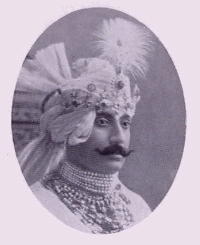| Wasif Ali Mirza Khan Bahadur | |||||
|---|---|---|---|---|---|
| Ihtisham ul-Mulk (Dignifier of the country) Raes ud-Daulah (Premier of the state) Amir ul-Omrah (Noble of Nobles) Mahabat Jang (Horror in War) | |||||
 | |||||
| Nawab Bahadur of Murshidabad | |||||
| Reign | December 1906 – 23 October 1959 | ||||
| Predecessor | Hassan Ali Mirza | ||||
| Successor | Waris Ali Mirza | ||||
| Born | 7 January 1875 Hazarduari Palace, Bengal, British India | ||||
| Died | 23 October 1959 (aged 84) Calcutta, West Bengal, India | ||||
| Burial | Jafarganj, West Bengal, India | ||||
| Spouse | See below | ||||
| Issue | See below | ||||
| |||||
| Dynasty | Najafi | ||||
| Father | Hassan Ali Mirza | ||||
| Mother | Amir Dulhan Kulsum-un-nisa Begum | ||||
| Religion | Shia Islam | ||||
Sir Sayyid Wasif Ali Mirza Khan Bahadur KCSI KCVO (Bengali: ওয়াসিফ আলী মির্জা; 7 January 1875 – 23 October 1959) was the Nawab of Murshidabad during 1906–1959. Sir Wasif Ali Mirza was educated at Sherborne School, Rugby School and later at Trinity College. He succeeded his father Hassan Ali Mirza Khan Bahadur at his death on 25 December 1906. On 11 December 1931, Wasif Ali was forced to surrender the administration of his estates to the Government of India after incurring a debt of ₹19 lakhs. On 15 August 1947, the Radcliffe Award allotted the district of Murshidabad to Pakistan and the flag of Pakistan was hoisted at the Hazarduari Palace but within two days the two dominions exchanged Khulna, which is now in Bangladesh, and then the flag of India was hoisted at the grand palace on 17 August 1947. The Government of India also resumed him all his estates in 1953. Wasif Ali was also the founder and president of the Hindu–Muslim Unity Association in the year 1937, named Anjuman-e-Musalman-e-Bangla, which promoted Hindu–Muslim unity. The Nawab also built the Wasif Manzil.
Sir Wasif Ali died at the age of 84 at his Calcutta residence at 85 Park Street in Calcutta on 23 October 1959. He was succeeded by his eldest son, Waris Ali Mirza Khan Bahadur.